The life of St. John the Baptist Through Icons and the Bible
by Marcella Speadbury
The Russian Church of the Ascension, Jerusalem
A few years ago I visited the Holy Land with a group from the British Association of Iconographers. I happened upon a little chapel in the grounds of The Russian Church of the Ascension on the far side of the Hedron valley from Jerusalem. The sun was streaming through the stained glass windows lighting up a handsome tiled floor into which a hollow has been cut. This was surrounded by an iron grille and marked the place where it is believed that St. John the Baptist’s head was thought to be found .

The Russian Church of the Ascension, Jerusalem
On the wall was a large picture of St John being beheaded; I instantly felt a deep sympathy for him and prayed that the executioner had a well-sharpened sword! This experience inspired me to research his life through the many exquisite icons of St. John that exist, and from relevant passages in the Bible and other sources. My only knowledge of St. John at that time was from readings in church and the Bible.
The Old Testament refers to John the Baptist in several passages, though not by name. One of these is under the ‘Proclamation of Hope’ [Isaiah 40:3-6]:
“A voice cries out, ‘Proclaim a message!’ Go up on a high mountain and proclaim the good news to Jerusalem!”
In the New Testament, similar forecasts are mentioned, particularly in Luke 3:4-6:
“The voice of one crying out in the wilderness: Prepare the way for of the Lord, Make his paths straight.”
The Conception of St. John the Baptist
The first chapter of Luke 1:1-45 recounts the story of John’s conception and birth to Zechariah (sometimes called Zachary), and Elizabeth:
“In the days of King Herod of Judea, there was a priest named Zechariah…and his wife Elizabeth. …they had no children, because Elizabeth was barren, and both were getting on in years. Once when he was serving as a priest before God… there appeared to him an angel of the Lord, standing at the right side of the altar of incense. When Zechariah saw him, he was terrified; and fear overwhelmed him. But the angel said to him, ‘Do not be afraid, Zechariah, for your prayer has been heard. Your wife Elizabeth will bear a son and you will name him John. You will have joy and gladness, and many will rejoice at his birth, for he will be great in the sight of the Lord. …even before his birth he will be filled with the Holy Spirit. He will turn many of the people of Israel to the Lord their God.”
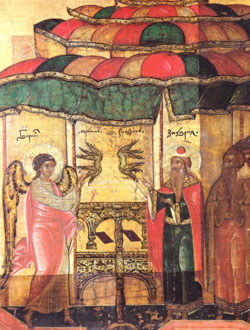
Icon of the Conception of John the Baptist by Semen Borozdin. Late 16th or early 17th century. The Russian Museum, St.Petersburg.
So, as with Jesus, John’s birth is announced by an Archangel in advance of the conception. Zechariah receives this proclamation of the Archangel with disbelief and is struck dumb.
Icon of the Conception of John the Baptist by Semen Borozdin. Late 16th or early 17th century. The Russian Museum, St.Petersburg.
This Icon shows the Holy of Holies in the Temple in Jerusalem. Zechariah is being blessed by the Angel of the Lord. Interestingly, other people are shown inside the Temple although the Bible relates that Zechariah was alone with the Angel. In Luke 1:13 it states that they were standing: “just to the right of the Altar of Incense”. However, in this icon, Zechariah and the Archangel are shown on either side of the Ark of the Covenant, creating a link with the Annunciation. The shape of the roof is very intriguing and unusual and reflects the colours of Zechariah’s robes. The icon itself is painted in the traditional technique of egg tempera on wood.
The Visitation of the Theotokos
When Elizabeth is about six months pregnant, her cousin, Mary, by this time pregnant herself with Jesus Christ, visits her and stays for about three months. Mary goes into Zechariah’s house and when Elizabeth hears her greeting, she was filled with the Holy Spirit. She cries out:
“Blessed art thou among women, and blessed is the fruit of thy womb. And whence is this to me, that the mother of my Lord should come to me? For, lo, as soon as the voice of thy salutation sounded in mine ears, the babe leaped in my womb for joy.”
Mary responds with the words we now call ‘The Magnificat’:
“My soul doth magnify the Lord, and my spirit hath rejoiced in God my Saviour. For he hath regarded the low estate of his handmaiden: for, behold, from hence-forth all generations shall call me Blessed. For he that is mighty hath done to me great things; and holy is his name. And his mercy is on them that fear him from generation to generation. He hath shewed strength with his arm; he hath scattered the proud in the imagination of their hearts. He hath put down the mighty from their seats, and exalted them of low degree. He hath filled the hungry with good things; and the rich he hath sent empty away. He hath protected his servant Israel, in remembrance of his mercy; As he spake to our fathers, to Abraham, and to his seed for ever.” [Luke 1:39-56]
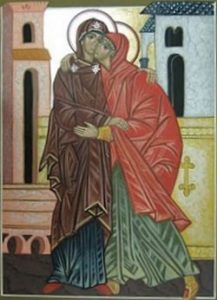
Contemporary icon, ‘The Visitation’ Anonymous Inspired by Luke 1:39-56
Contemporary icon, ‘The Visitation’ Anonymous Inspired by Luke 1:39-56
Note how gentle these faces are, pressed together with affection. Elizabeth is lower than Mary in a posture of humility and submission. The three stars on Mary’s head and shoulders represent her virginity although only two stars should be visible as Elizabeth shoulder is covering the normal position of the third star.
The Nativity of St. John the Baptist
There are several passages within the Old Testament which are interpreted by Christians as being prophetic of John the Baptist. These include a passage in the Book of Malachi 3:1 that refers to a prophet who would prepare the way of the Lord:
“Behold, I will send my messenger, and he shall prepare the way before me: and the Lord, whom ye seek, shall suddenly come to his temple, even the messenger of the covenant, whom ye delight in: behold, he shall come, saith the LORD of hosts.”
Ein Karem in the Jerusalem Hills is traditionally considered the birthplace of John the Baptist. John was born as the days began to grow shorter. Christ was born in winter as the days were growing longer, since it was fitting that John’s status should diminish and the glory of God increase. Many spiritual writers, as in a homily of Rabanus Maurus, Archbishop of Mainz (784-856), consider that this mirrors John’s statement: “He must grow greater and I must grow smaller.” The Nativity of John the Baptist is observed by the Church as a holy event on June 24th. This is exactly six months before the Nativity of Christ.
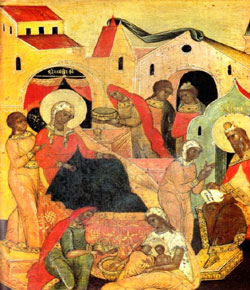
Icon of the Birth of John the Baptist
Icon of the Birth of John the Baptist
This Festival Icon is based on a text in the Gospel of Luke 1:57-64. The buildings in the background are linked by a veil, indicating that the scene is taking place inside. Elizabeth, shown (as is Zechariah), with a halo implying sainthood is sitting on a couch attended by a midwife. Guests have arrived bearing gifts. The bringing of gifts reminds us of the Nativity of Christ and the arrival of the Kings. At the foot of the bed two nurses are bathing the baby. Zechariah is inscribing onto a tablet “His name is John”, despite the fact that the family objected to the use of a non-family name. The figure with her back turned to Elizabeth may be protesting about the name that is to be given to the baby! John means ‘God is gracious’.
Zechariah’s voice is restored with the naming of John.
Russian icon of the birth of John the Baptist (circa 1700)
This second Icon of the Birth of John is very similar to the first but with the addition of the supporting saints of Florus and Laurus at the top of the border on the left and right. To the left, Elizabeth is reclining on her bed and two nurses are performing the ritual washing of John in a font. There is only one visitor bringing a gift in this icon. However, the image of God appears top centre looking down on the scene. As in the first nativity icon, both Elizabeth and Zechariah are shown with halos and the latter is wearing the iconographical headdress of a prophet.
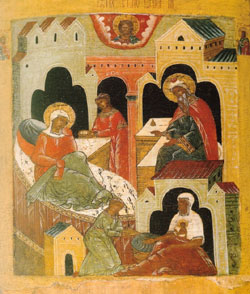
Russian icon, circa 1700 (73×56.8cm.)
John the Baptist marks the boundary between the Old and New Testaments. Indeed, the Lord speaks of him in these terms when he says that the Law and the Prophets of the Old Testament are valid until the coming of John the Baptist. John is the representative of the past, and it was therefore fitting that he should be born of elderly parents, yet, while still in his mother’s womb, he was declared to be a prophet in recognition of his future role. In the womb he was already designated by God to be Christ’s precursor.
John is also regarded as a prophet in Islam, the Baha’i faith and Judaism. He is mentioned by the Jewish historian, Josephus (AD37-c.AD101) and, in the Qur’an, John is one of the twenty- five Prophets in whom Muslims believe.
I found the following quotation in the Qur’an:
“O John! Hold fast the Book with all your strength. We had bestowed wisdom upon him while he was still a child; and also endowed him with tenderness and purity; and he was exceedingly pious and cherishing to his parents. Never was he insolent or rebellious. Peace be upon him, the day he was born, and the day he will die, and the day he will be raised up alive.”[Quran: 12-15]
Christians commonly refer to John as the Precursor or Forerunner of Jesus. John is known as ‘O PRODROMOS’ – ‘PRO’ meaning ‘before’ and ‘DROMOS’ ‘way’ or ‘road’. In a Samaritan manuscript in Aramaic, John is referred to as ‘YOHANA AMUDANI’, ‘The Baptist’.
Orthodox Prayer
As a fair morning running before the sun, the offspring of barren parents clearly proclaims the conceiving of the Virgin, making the illumination of godliness and grace shine to the ends of the whole inhabited earth. By thy birth, O Forerunner, the night of ungodliness was driven from the earth and the rays of grace were spread to the ends of the world; for thou dost reveal the sun that knows no evening.
Liturgical Prayer
O God who hast made this an honoured day for us by the birth of Saint John: bestow upon Thy people the grace of spiritual joys, and guide the hearts of all Thy faithful into the way of eternal salvation.
St. John the Baptist: Life as a Prophet
“The child grew and became strong in the spirit, and he was in the wilderness until the day he appeared publicly to Israel.” [Luke 1:80]
Little is known about John the Baptist’s life until he becomes a Prophet in the desert around the time that Jesus began his ministry. He lived in the wilderness, in the desert of Judea, as an ascetic leading a life of austere self-discipline and renouncing all material comfort. His food was locusts and honey and he is traditionally depicted as wearing a rough garment of camel hair with a leather belt. There are several passages in the Old Testament which are interpreted by Christians as being prophetic of John the Baptist. These include a verse in the Book of Malachi [3:1] that refers to a prophet who would prepare the coming of the Lord.
“Behold, I will send my messenger, and he shall prepare the way before me: and the Lord, whom you seek, shall suddenly come to his temple, even the messenger of the covenant, whom ye delight in: behold, he shall come, saith the LORD of hosts.”
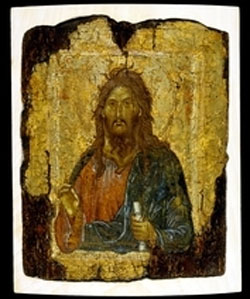
St. John the Baptist Byzantine c. AD1300 Constantinople (modern Istanbul, Turkey) (25.1×20.2cm) British Museum
This icon is a compelling image of St. John who appears to be gazing at us projecting a sense of wisdom and sincerity. He has long wild hair and a straggly beard and wears a green mantle and under his red tunic, a hair shirt. He holds his right hand in blessing and has a scroll in his left hand indicating that he is a preacher. On the halo are the inscriptions ‘St John’ and the Greek ‘O Prodromos’ [the Forerunner] in red. John is normally shown, as in this icon, with emaciated features, ruffled hair, a straggly beard and a wrinkled cloak over a rough garment of camel’s hair indicative of an ascetic life [Matthew 3-4]. The garments are often painted as though they are shining with light; in the Bible, light is the first creation of God, the ultimate symbol of his glory.
When he was thirty, John began to preach on the banks of the Jordan and when he spoke of the coming of the Lord, he was asked: “Who are you?”, and he replied: “I am the voice of one crying in the wilderness”.
“John was indeed a voice that lasted only for a time; Christ, who is the Word from the beginning, is eternal” (taken from a sermon of St Augustine).
The Saviour testified to John’s greatness when he said that “among those born of woman there has arisen no one greater than John the Baptist”, [Luke 7:8, Matthew 11:11]. Jesus said :“John is greater than the Prophets” [Luke 24:26]. However, John himself said: “He who comes after me ranks before me, and I am not worthy to undo the strap of his sandal” [Mark 1:7].
The Gospel relates that Jesus regarded John as “a burning and shining lamp” [John 5:35], and understood that He was “willing to rejoice for a while in his light” [John 5:35]. The book of Acts portrays the disciples of John as eventually merging with the followers of Jesus [Acts 18:24, 19: 6].
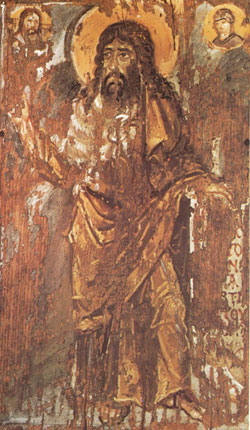
Czechoslovakia, 6th century
Icon from Czechoslovakia, 6th century
This encaustic image is now to be found in Kiev, Russia. It is one of the oldest icons in existence and has been dated to the 6th century although according to comments in the book ‘The Icon’ by Kurt Weitzmann, it could have been painted a little earlier. The Greek lettering translates as “Behold the Lamb of God which taketh away the sins of the world”. [John 1:29] John is standing at ease. His hand is raised pointing towards Christ, seen here in a medallion bust in the left-hand corner. A medallion bust of the Virgin can be seen upper right. This shows that they are the intercessors, Mary for the new and John for the old. John is the prophet of the wilderness and he is shown, typically, with dishevelled hair, a sombre brown tunic and mantle. In addition, he is wearing an olive grey sheepskin known as a melote. His face is emaciated and expressing pain.
St. John the Baptist, the Wandering Prophet. Bulgarian 16th/17th century, possibly painted by Fyodorvech Ushakov.
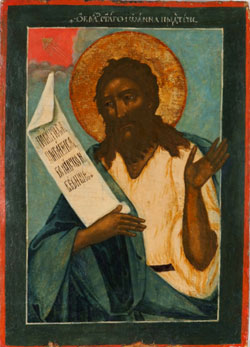
St. John the Baptist, the Wandering Prophet. Bulgarian 16th/17th century, possibly painted by Fyodorvech Ushakov.
In this icon in the left hand corner, we can see the radiance of God. John wears a camel hair tunic with a leather belt around his waist. His hand is raised in blessing and his face is thoughtful with a sad expression. John is holding a scroll inscribed with the words “Turn away from your sins”. He is urging repentance because of the imminent appearance of the Messiah.
The Assembly of the Baptist: Detail from a ‘Six Day Icon’, School of Novgorod
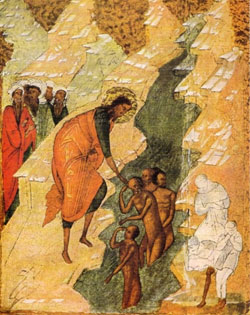
The Assembly of the Baptist: Detail from a ‘Six Day Icon’, School of Novgorod (from the book ICONS introduced by T. Talbot Rice).
In the design of this Icon, the hills play an important part. They remind one of the steep cliffs of the Jordan, where the actual event of baptising took place. These cliffs are drawn in perspective and the river really does look as if it is running through the hills.
People came to John from Jerusalem, the whole province of Judaea and from the countryside near the River Jordan where he baptised them, saying: “Turn away from your sins because the Kingdom of God is near” [Matthew 3:2].
The Jewish authorities in Jerusalem sent priests and Levites to ask John who he was. He replied: “You yourselves are my witnesses that I said I am not the Messiah but I have been sent ahead of Him..” [John 1:20].
John anticipated a Messianic figure who would be greater than himself and in the New Testament Jesus is the one whose coming John foretold.
One day, Jesus came from Galilee to John, to be baptised by him. John would have prevented him, saying, “I need to be baptised by you, and you come to me?”. But Jesus answered: “Let it be so for now; for it is proper for us to fulfil all righteousness”. Then John consented. [Matthew 3:13]
It is believed that John baptised Jesus at “Bethany beyond the Jordan called Bethabara” (described in the King James version of the Bible).
And when Jesus had been baptised, just as he came up from the water, suddenly the heavens were opened to him and he saw the spirit of God descending like a dove alighting on him. And a voice from Heaven said: “This is my Son, the Beloved, with whom I am well pleased” [Matthew 3:17].
Icon from the School of Ukraine, 16th century. Held in the Museum of Ukrainian Figurative Art, Kiev
This icon shows Christ in the waters of the Jordan. Three angels are bowing their heads in awe as they witness the Baptism.
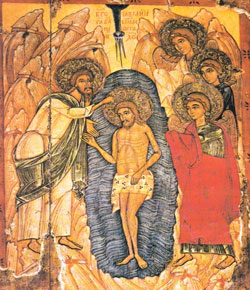
Icon from the School of Ukraine, 16th century. Held in the Museum of Ukrainian Figurative Art, Kiev (43.5x36cm)
A three-partite ray comes down from God in the sky and even the mountains seem to be bowing towards the river. During the Theophany Vigil it is said: “He immerses in the waves of the Jordan not as though he needs waves for His purification but he prepares our revival”. The act of baptising Jesus made Holy, once and for all, the waters of baptism; these are known as the Primordial or Blessed Waters.
The following words are taken from Psalm 97:5 and are used in the Canon of the Vigil when celebrating the baptism:
“O Lord, we glorify you as our God and Saviour. You are the wonderful glory of the Father, enlightening those who are in darkness, a sun that never sets, you came to shed light on everything with your holy baptism.”
Tver, 1430-1440, Russian State Museum, St Petersburg
Icons of the Baptism [Theophany] are dedicated to one of the main twelve liturgical feasts, the Baptism of Jesus Christ. This marks the beginning of the ministry of Christ for the salvation of humankind and his first manifestation as the Son of God. This icon was one of the festal tier of a large iconostasis. The Feast of the Baptism, or Theophany of the Lord, was one with Christmas and was called the “Feast of Light”.
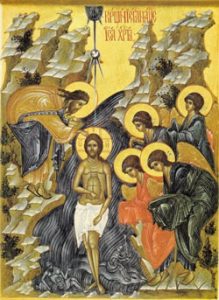
Tver, 1430-1440, Russian State Museum, St Petersburg, (103x80cm)
In this version of the Baptism of Christ, there are two allegorical figures which are placed at the feet of Christ: an old man, sometimes illustrated wearing a crown that personifies the Jordan, and a second figure sitting on a fish that represents the sea. They illustrate the Psalm 114:3-8: “The sea looked and fled, the Jordan turned back”. John the Baptist, full of fear and wonder, bows reverently towards Christ, almost afraid to touch his head. The light which radiates from Christ saturating the linen seems to illuminate the figure of John. Christ is shown wearing a cloth around his loins and with the angels bending over him. The Baptist is wrapped in a cloak of yellow ochre. In this icon, the theme is the beginning of the transfiguration of the world. The only witnesses are John the Baptist and the four angels who have come down from heaven to witness the incarnate God on Earth.
“With fear and wonder, as once in heaven, so now at the Jordan the angels adoringly contemplated God’s humility once more” (Cosmas of Maiuma, Canon of the Feast of the Baptism).
An ancient tradition of the Church states that: “When Christ was baptised, flames were seen above the water”. In the prayers of the Vigil of the Feast of the Baptism, speaking to Christ, John the Baptist compares him to fire and himself to dry straw: “You come to me, and I, like straw, don’t dare come near the fire. Make me Holy, Lord, by your divine presence”.
This Icon of the Baptism depicts an axe at the base of a tree and it reminds us of John’s prophetic declaration: “Even now the axe is laid to the roots of the trees, so that any tree that fails to produce good fruit will be cut down and thrown on the fire” [Matthew 3:1].
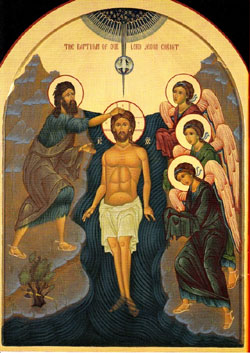
This modern icon appeared in ‘Bible Alive’ without attribution
The Baptism of Jesus represents not only the beginning of Christ’s ministry in the world, but also the manifestation of the three hypostases of the Trinity:
“O Lord, the glorious Trinity was manifested at your baptism in the Jordan: the voice of the Father witnessed to you, calling you his beloved son, and the spirit, in the form of a dove, has confirmed the truth of these words. You appeared, O Christ God, and the world was enlightened, glory to you” [ Troparion of the Feast].
The Angel of the Desert.
In this icon, John is depicted with a pair of angel’s wings. This symbolises his vocation as God’s
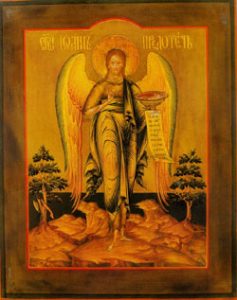
St. John the Baptist, Palekh School, mid 19t hcentury. Wood, gesso ground, egg tempera, gold. (30.7×24.3 cm)
messenger [the literal meaning of the word ‘angel’], and is a symbol of his angelic way of life. The wings are nearly always overwritten with ‘assist’ [gold lines]’ or ‘chrysography’, the art of writing in letters of gold to emphasize John ‘swimming’ in the divine dimension. John holds a chalice containing the Lamb of God, Jesus Christ. As in the above icon, this icon also depicts an axe at the base of a tree.
The Beheading of St. John the Baptist
In Luke 7:11, we understand that John is discouraged. He had denounced King Herod for living with his brother’s wife, Herodias. John took a stand against sin and was not afraid to speak his mind! He told Herod: “it is unlawful to have her”. Herod has John arrested and chained in a prison cell.
Whilst he was in prison, John the Baptist heard about Christ’s preaching and sent some of his disciples to ask Him: “are you the one John said was going to come, or should we expect someone else?”. Jesus answered, “Go back and tell John what you are hearing and seeing”.
In Matthew 14:3-12, we read about John’s beheading.
As the people regarded John as a prophet, Herod did not kill him. However, on his birthday, Salome, daughter of Herodias, danced before Herod who had sworn to give her anything she wanted. Her mother persuaded Salome to ask for the head of John the Baptist on a platter and because Herod had given his word, and in order not to be humiliated in front of his guests, he commanded that it be given to her.
After his beheading, John’s disciples came and took the body and buried it (traditionally believed to be in Sebastia near modern-day Nablus in the West Bank); they then went and told Jesus. When Jesus heard this, he withdrew by boat to a deserted place, grieving and seeking peace and solace [Matthew 14:13].
The news of the death of John foretold Jesus’ own death.
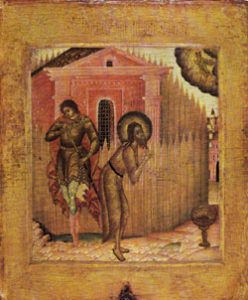
The Beheading of John the Baptist. Russian, Stroganov School, 17th century, Recklinghausen Museum
The Beheading of John the Baptist. Russian, Stroganov School, 17th century, Recklinghausen Museum
This is a typical work of the Stroganov School: it is a miniature and uses delicate colours and fine meticulous brushwork. The backgrounds are often quite complicated as in this example. The delicacy of the postures and gestures of the swordsman and St. John, and the richness of the swordsman’s vestments, are also typical of this School.
St. John the Forerunner – Angel of the Wilderness.
This icon shows the severed head held by a miraculously whole John. By showing the decapitated head but not the body, the icon emphasises John’s detachment from the desires and sins of the flesh having been freed from personal sin while still in Elizabeth’s womb at the moment of his encounter with Christ during the Visitation from Mary [see Luke 1:41].
The Feast of Beheading of St. John the Baptist is held on 29 August in both the Eastern and Western Churches. Eastern Christians fast on this day in honour of John’s asceticism and in symbolic rejection of the drunken banqueting that precipitated his murder.
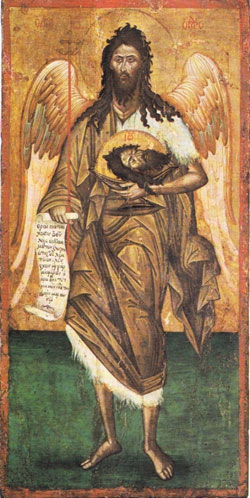
St. John the Forerunner – Angel of the Wilderness. Greek icon 15th/16th century. Lev Zubelov collection. (90.5×45.5cm)
The Feast reminds us that John’s death will soon be followed by Christ’s own sacrificial death on the Cross. Jesus Himself confirmed this when he said to his disciples: “I tell you that Elijah has come already and they did not recognise him but treated him as they pleased; and the Son of Man will suffer similarly at their hands” [Matthew 17:12-13].
The disciples understood then that He had been speaking of John the Baptist.
John’s mission as The Forerunner did not end with his martyrdom: he prepared the way for Christ even in the world of the dead. As the Orthodox vigil office for this Feast says:
“Therefore, having greatly contended and suffered for the truth, thou hast gone rejoicing to declare to those in hell the good tidings of God having appeared in the flesh, taking away sins of the world and granting us mercy.
The tongue that speaks of divine things is sent to those in hell and is a fore-announcer of Christ.
The glorious beheading of the Forerunner is part of a certain dispensation, for John preached in hell the coming of the Saviour: ‘…as martyr, thy head has been cut off by the sword and thou hast fore-announced him to those in hell’”.
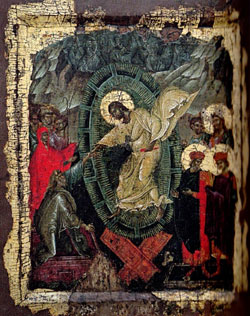
Icon with the Anastasis, early 14th century. Ohrid, Macedonia. Egg tempera and gold on wood. (44×36 cm)
This icon, known as The Anastasis (Christ’s descent into Hades), shows John the Baptist pictured on the right above King Solomon and King David. John had preceded Christ’s visit into Hades (Hell), to prepare the way for the risen Lord. The Anastasis is used in the Orthodox Church for the Feast of the Resurrection. Christ is seen in glory, breaking down the gate of Hell. In this icon, Christ sweeps down to Hades, leaving a trail of light, his garments billowing out behind him. At the top, two angels are carrying the instruments of the crucifixion. Eve is waiting with her son, Abel. Behind Christ is the Mandorla with shining bright rays indicating Christ’s Divinity.
The Third Finding of the Head of St. John the Baptist
According to tradition, the head of St. John the Baptist was buried on the Mount of Olives where it remained hidden until the fourth century when the First Finding occurred during the construction of a church on the Mount. A vessel containing the head of John was discovered but reburied for fear of vandalism by unbelievers.
After the Second Finding in the year 452, as a result of a vision by two monks on a pilgrimage, it is said that the head was reburied in a cave near Emesa (now Homs in Western Syria), where a monastery was eventually built. The Feast of the First and Second Finding of the Head is observed on February 24th
The Third Finding of the Head occurred around the year 850 when it was revealed to the Patriarch Ignatius of Constantinople in another vision that the head of St. John was hidden in Comana (modern Turkey), to where it had been removed during a period of iconoclastic persecution circa 820. The head was found and transferred to Constantinople where it was placed in a church at the Court. The Feast of the Third Finding is observed on May25th.
Today, several different locations claim to possess the severed head of John the Baptist, among them Amiens Cathedral in France, brought there after the Fourth Crusade, and the San Silvestro in Capite in Rome. The truth is impossible to determine.
Icon of the Third Finding of the Head of John the Forerunner
This gilded icon with a decorative border, known as The Icon of the Third Finding of the Head of John the Forerunner, shows (possibly) Patriarch Ignatius of
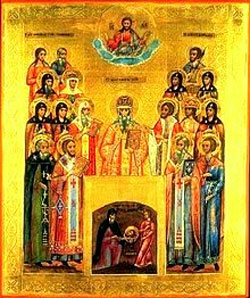
Icon of the Third Finding of the Head of John the Forerunner, Konetz, Russia, 19th century
Constantinople (797-877) surrounded by many Russian saints. The Patriarch, who had a vision showing where the head of St. John had been hidden, ordered that it be transferred to Constantinople. Christ is shown at the top of the icon looking down on the scene.
Hymns
Troparion [Tone 4]
As a divine treasure hidden in the ground
Was your head revealed to us by Christ, o prophet and forerunner.
We have gathered in commemoration of this finding
With the inspired hymns of praise to the Saviour,
Who saves us from corruption through your prayers!
Kontonion [Tone 4]
By giving your venerable head to a sinful woman,
Herod broke the law of God.
But we behold it and cry out with joy,
And say to you, o forerunner;
Pray to the Lord that He
May grant mercy to us all!
Finally, I would like to show you two icons that I am interested in painting. The first is one that I am currently working on from the ‘Deesis’ Cycle:
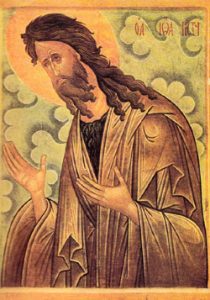
Icon from the ‘Deesis’ Cycle, 1st half 15th century, School of Andrei Rublev.
John always holds a special place in the Iconastasis. He is seen in ‘Deesis’, (a prayerful posture with his hands raised in supplication), and would be standing next to Jesus on his left. This image was painted in the first half of the fifteenth century and shows deep sorrow in John’s expression. The face is beautifully modelled with pale highlights used to emphasize his suffering. The colour scheme subtly blends together pale ochres and browns.
The second icon is from a miniature iconostasis which families would take with them when travelling:
This icon shows John the Baptist in unusually decorative garments shown in typical iconographical style. The hands are particularly graceful in an attitude of supplication.
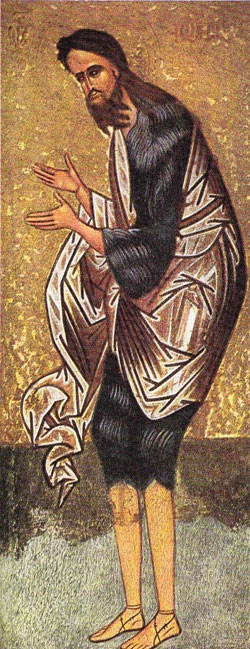
Detail from a travelling iconostasis of St. John the Baptist from the School of Moscow, late 15th century
I am so grateful for that chance discovery of the chapel in the convent grounds with the beautiful tiled floor reflecting the stained glass windows where I became an admirer of St. John the Baptist.
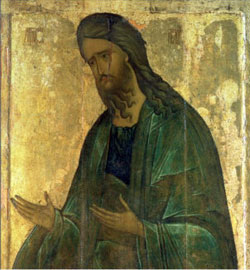
St. John the Baptist, Andrei Rublev 15th century Andrei Rublev Museum, Moscow
St. John the Baptist was the last and the greatest of the Prophets, bringing the Old Testament to an end; he is also the first of the Messiahs to initiate the New Testament era. I hope that my paper has succeeded in demonstrating what an important role he played in the life of Christ and the inspiring example he gave us of how we should live our own lives.
DEDICATED TO DELL, (DEREK INGRAM), A DEAR FELLOW STUDENT ON AIDAN HART’S COURSE. HE COMPLETED TWO YEARS WITH US BEFORE BEING CALLED TO GOD’S KINGDOM.
=========================
Marcella Speadbury
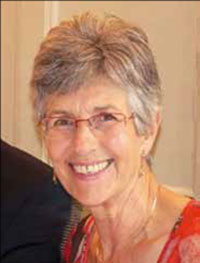
Marcella Speadbury
After nearly forty years working as an occupational therapist Marcella’s dream was to attend art classes. A year later she answered a ‘call’ to
paint an icon with Sr Esther. Subsequent courses took her to Russia and Finland and her whole life has changed, especially her prayer life. She was chosen to join Aidan Hart’s diploma course on liturgical art and recently was featured on the BBC programme Songs of Praise in ‘Creative Stratford’. Marcella says for her iconography is a wonderful way to spread the word of God, and He is using her in surprising ways!
